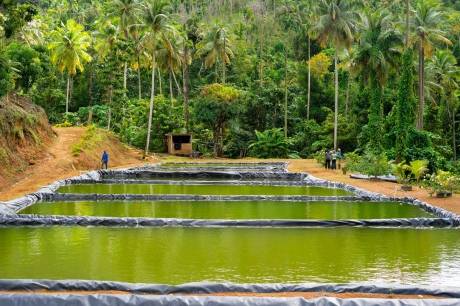
Marvin Daniel recalls the terrifying winds and torrential rains that destroyed lives and livelihoods when they lashed the Caribbean island of Dominica. Not once but twice.
“We were fighting for our lives. We were scrambling for cover,” Marvin recalls.
The 35-year-old experienced first-hand the devastation caused first by Tropical Storm Erika in 2015 and then Hurricane Maria in 2017. He was a manager at a luxury hotel when the second disaster claimed thousands of lives and caused widespread damage across the Caribbean. Sixty-five people died on Dominica alone
“We thought we were finished,” he says. “Our resort was devastated.”
With his employment gone, Marvin turned his attention to aquaculture as FAO joined the Government of Dominica in its efforts to rejuvenate prawn production and make it a priority for country’s sustainable development.
Aquaculture had once been an important part of Dominica’s economy and local giant river prawns are highly valued there. However, the tiny nation’s aquaculture sector had diminished over the years as the government shifted its attention to other industries.
Marvin had always wanted to start his own business. Now he and other farmers were grateful for the joint project which involved the rehabilitation of the government’s hatchery and the enhancement of aquaculture research. Concrete walls were installed around the structure and hurricane roof ties were added to the rafters.
“The island’s small aquaculture sector was devastated by the disasters and this project has tried to rehabilitate the hatchery and make it climate resilient so it can withstand future impacts,” says Iris Monnereau, FAO’s Regional Project Coordinator of the Climate Change Adaptation of the Eastern Caribbean Fisheries (CC4FISH) project.
Freshwater prawns are a high-value product in Dominica and other Caribbean islands. Production is not as technical or capital-intensive as the aquaculture of sea prawns, making it more accessible to small-scale operators. ©FAO/Dwayne Benjamin
Rising sea levels, changing rain patterns and temperatures and the increasing incidence of high intensity storms and hurricanes will continue to affect lives and livelihoods, particularly in Small Island Developing States like Dominica.
The island country currently imports a significant amount of the fish and fish products it consumes, and climate change is expected to have a negative effect on marine fish catches.
FAO’s action in Dominica is part of a broader initiative of the CC4FISH project that aims to reduce the vulnerability of fisheries and aquaculture and increase resilience.
“CC4FISH builds knowledge and awareness,” says Monnereau. “It also supports capacity building of fisherfolk, fisher organizations and aquaculturalists. The project aims to rehabilitate and build the aquaculture sector through demonstration farms, the rehabilitation of hatcheries and capacity building activities.”
Prawn farming: an untapped market
Freshwater prawn farming has the potential to supply local markets as well as other islands in the Caribbean with a high-value product. In addition, its production is not as technical or capital-intensive as the aquaculture of sea prawns, making it more accessible to small-scale operators.
The main challenge is ensuring a ready supply of larvae, or ‘prawn seed’, for stocking commercial ponds since previously imported larvae had a high mortality rate. The first batch of local larvae was produced at the hatchery last August and larvae have since been distributed to several farms.
Marvin has received 80 000 larvae for his ponds and boasts a 98 percent survival rate of his stock. He is now encouraging other farmers to try prawn farming.
“A number of farmers have invested in establishing farms for growing high value prawns for local demand and this provides them with renewed livelihoods and opportunities for growth,” says Jullan Defoe, Dominica’s Chief Fisheries Officers and CC4FISH focal point.
Mia Avril, an aquaculture development consultant with FAO based in Dominica, is encouraged by the early results. “So far we have supplied six farmers,” she says. “It is expected between now and the end of the project we will be able to supply upward of 20 farmers.”
FAO’s CC4FISH project in Dominica and the Caribbean aims to increase resilience and reduce the vulnerability of fisheries and aquaculture to natural disasters and other shocks. ©FAO/Dwayne Benjamin
Despite the COVID-19 pandemic, tourism remains a key industry in the Caribbean and prawns can be sold to the hospitality industry and at local fish stalls and supermarkets. Marvin says Dominica will eventually be able to export them to the neighboring French territories of Guadeloupe and Martinique.
“We need to have enough food to feed our population, and it has to be affordable for the locals,” Marvin concludes.
The CC4FISH project spans seven countries in the Eastern Caribbean – Antigua and Barbuda, Dominica, Grenada, Saint Kitts and Nevis, Saint Lucia, Saint Vincent and the Grenadines and Trinidad and Tobago. By building up the aquaculture industry and making it climate resilient, FAO is helping these Eastern Caribbean islands strengthen their food security, livelihoods and household income.
For further details refer http://www.fao.org/fao-stories/article/en/c/1394703/
















